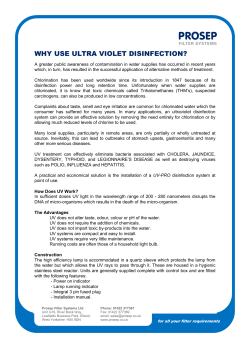
The Biocidal Products Committee adopts five - ECHA
Annex Disclaimer: This is a translation of the original. The original version is available in English on the ECHA website. The Biocidal Products Committee adopts five opinions Six other opinions expected to be adopted by written procedure. Helsinki, 20 April 2015 Annex to the news alert ECHA/NA/15/11 More information about the adopted opinions The adopted opinions concern and support the approval of the following active substances and their product-types (PTs): C(M)IT /MIT for PT 2, 4, 12 and 13 The reaction mass of 5-chloro-2-methyl-2h-isothiazol-3-one and 2-methyl-2h-isothiazol-3-one (3:1) (CMIT/MIT) is an existing active substance evaluated in PTs 2, 4, 6, 11, 12 and 13. The active substance is a skin sensitiser Cat1A and therefore biocidal products containing the active substance at or above sensitising concentrations can not be approved for non-professional users. CMIT/MIT is used to control the growth of bacteria, algae and fungi in sump water of air conditioning and air washer systems (PT 2); in pasteurisation tunnels and as an additive to conveyor lubricants (PT 4); in papermill and oilfield injection systems (PT 12) and in metal working fluids (PT 13). The opinions on PTs 6 and 11 were adopted at BPC-9. The evaluating competent authority of the active substance application is France. Ampholyt for PT 3 Ampholyt is an existing active substance evaluated in PTs 2, 3 and 4. Products containing ampholyt are used in treatments to surfaces, walls, and floors in animal health and veterinary areas, including footbaths (PT 3) by professionals to prevent the spread of various micro-organisms. The evaluations for PTs 2 and 4 will be discussed at a later BPC. The evaluating competent authority of the active substance application is Ireland. The following opinions are expected to be approved by written procedure, pending the agreement on the reference specification, which will be part of the written procedure: Peracetic acid for PTs 1, 2, 3, 4, 5 and 6 Peracetic acid is an existing active substance evaluated in PTs 1 to 6. Uses evaluated include disinfection of human skin (PT 1), laundry disinfection, disinfection of sewage/waste water, disinfection of surfaces in industrial, public and health care areas, CIP (Clean-in-Place) in pharmaceutical and cosmetic industry (PT 2), disinfection of animal houses (PT 3), disinfection in food and feed industry (CIP, dipping of equipment, automated spraying, and manual spraying, foaming) (PT 4), disinfection of animal drinking water (PT 5) and in-can preservation in paper production (PT 6). The evaluating competent authority of the active substance application is Finland. Further information The opinions will be available at the following link in the near future: Biocidal Products Committee Background Information The role of BPC in EU regulatory processes The Biocidal Products Committee prepares the opinions of the Agency related to several processes under the Biocidal Products Regulation. Each EU Member State is entitled to appoint one member to the BPC for a renewable term of three years. In relation to applications for the approval of new active substances, companies have to apply for approval of an active substance by submitting a dossier. After a validation check, the evaluating competent authority carries out an evaluation within one year. The result of the evaluation is forwarded to the BPC, which prepares an opinion within 270 days. The opinion serves as a basis for decision-making by the European Commission and the Member States. The approval of an active substance is granted for a defined number of years, not exceeding 10 years. Substances which were on the market before 14 May 2000 and are evaluated under the biocides review programme in an analogous manner to new active substances, are referred to as existing active substances. During the approval process of an active substance, the evaluating competent authority may conclude that the active substance meets the criteria for substitution of Article 10(1) of the BPR and is therefore a potential candidate for substitution. The objective of this provision is to identify substances of particular concern to public health or the environment and to make sure that these substances are phased-out and replaced by more suitable alternatives over time. The criteria for substitution are based on the intrinsic hazardous properties in combination with the use and include, for example, if the substance meets at least one of the exclusion criteria listed in the BPR or if the substance is a respiratory sensitiser. For substances that are identified by the evaluating competent authority as a potential candidate for substitution, ECHA will initiate a public consultation to allow interested third parties to submit relevant information, including information on available substitutes. Subsequently, in the preparation of its opinion, the BPC reviews the proposed identification of the active substance as a candidate for substitution. Active substances which are candidates for substitution will not be approved for more than seven years, even in the case of renewal. If the active substance meets one or more exclusion criteria, it will only be approved for five years. When an active substance is identified as a candidate for substitution, products containing that active substance will have to be subject to a comparative assessment at the time of authorisation and will only be authorised if there are no better alternatives. Annankatu 18, P.O. Box 400, FI-00121 Helsinki, Finland | Tel. +358 9 686180 | Fax +358 9 68618210 | echa.europa.eu
© Copyright 2025









